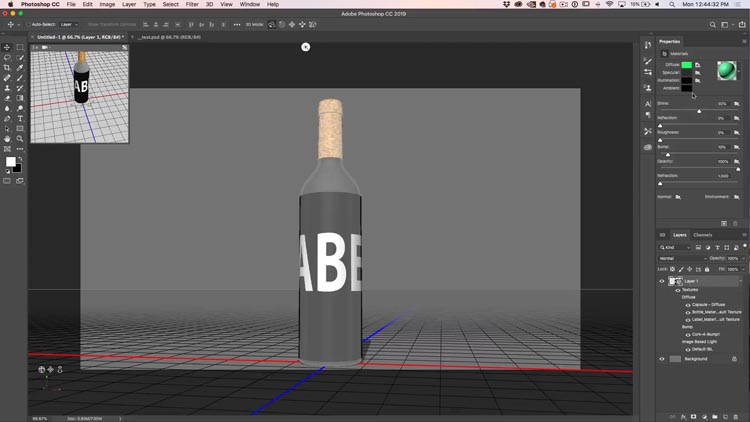
Adobe Photoshop CC 2019, a cornerstone in the realm of digital imaging, pushed the boundaries of creative expression by integrating robust 3D features into its versatile toolkit. This comprehensive guide aims to explore the intricacies of Adobe Photoshop CC 2019’s 3D capabilities, offering users an in-depth understanding of the tools and techniques available. From basic introductions to advanced methods, this guide provides a roadmap for artists and designers looking to delve into the captivating world of 3D design within Photoshop CC 2019.
Understanding the Basics of 3D in Photoshop CC 2019
Adobe Photoshop CC 2019’s 3D features open up a realm of possibilities for artists, allowing them to create three-dimensional objects, scenes, and text directly within the application. The foundational concepts include:
- 3D Layers and Objects: Photoshop CC 2019 introduces 3D layers, enabling users to convert text, shapes, and raster layers into three-dimensional objects. These layers can be manipulated in three-dimensional space, providing depth and perspective to the digital canvas.
- 3D Tools Panel: The 3D Tools Panel is a hub for accessing and controlling various 3D elements in Photoshop CC 2019. Users can find tools such as the Move Tool, Rotate Tool, and Scale Tool, each tailored for specific 3D manipulation tasks.
- Lighting and Shadows: Realistic lighting and shadows are pivotal in creating convincing 3D scenes. Photoshop CC 2019 offers a range of lighting options, allowing users to experiment with directional lights, spotlights, and ambient light to achieve the desired visual effects.
- Materials and Textures: The ability to apply materials and textures to 3D objects adds depth and realism to compositions. Users can import textures, adjust materials, and experiment with specular highlights and reflections to enhance the visual appeal of their 3D creations.
Exploring Adobe Photoshop CC 2019’s 3D Features
- 3D Extrusion: Shaping Ideas into Reality
3D Extrusion is a fundamental feature that allows users to convert 2D layers into 3D objects. Whether working with text or shapes, the 3D Extrusion feature enables users to give depth and dimension to their designs. By adjusting parameters such as depth and bevel, users can customize the appearance of extruded objects to suit their creative vision.
- 3D Materials and Textures: Crafting Realism in Virtual Space
Photoshop CC 2019’s 3D features offer extensive options for applying materials and textures to 3D objects. Users can import custom textures, adjust material properties, and experiment with bump maps and specular settings to achieve lifelike surfaces. This feature is particularly valuable for artists aiming to create realistic renders of products or environments.
- 3D Camera Tools: Navigating the Virtual World
The 3D Camera Tools in Photoshop CC 2019 provide users with control over the viewpoint and perspective of their 3D scenes. By manipulating the camera position, rotation, and field of view, artists can craft dynamic compositions and showcase their 3D creations from different angles.
- 3D Mesh Deformation: Sculpting Virtual Clay
Photoshop CC 2019’s 3D capabilities extend to mesh deformation, enabling users to sculpt and shape 3D objects as if working with virtual clay. This feature is invaluable for artists who seek to add unique details or customize 3D models for specific design requirements.
- 3D Printing: From Virtual to Physical
Photoshop CC 2019 embraces the growing field of 3D printing by offering tools for preparing 3D models for physical reproduction. Users can analyze and repair models, adjust print settings, and export files in formats compatible with 3D printers. This integration opens doors for artists to bring their digital creations into the tangible world.
Advanced Techniques for 3D Mastery
- Advanced Lighting Techniques: Crafting Atmosphere and Drama
Going beyond basic lighting setups, advanced lighting techniques in Photoshop CC 2019 allow users to create atmospheric effects and dramatic scenes. By experimenting with multiple light sources, adjusting shadow settings, and utilizing techniques like rim lighting, artists can elevate their 3D compositions to cinematic heights.
- Creating 3D Text: Typography in the Third Dimension
Photoshop CC 2019’s 3D text capabilities empower users to create captivating typography in three-dimensional space. From extruding text layers to applying intricate materials and lighting, artists can use 3D text to add a dynamic and eye-catching element to their designs.
- Importing 3D Models: Expanding the Creative Toolbox
Adobe Photoshop CC 2019 allows users to import 3D models created in external applications. By seamlessly integrating external models into Photoshop, artists can incorporate complex 3D structures, characters, or objects into their compositions, expanding the creative possibilities of their designs.
- Animating 3D Objects: Breathing Life into Designs
Photoshop CC 2019’s timeline feature enables users to animate 3D objects directly within the application. By setting keyframes, adjusting positions, and experimenting with animation effects, artists can bring their 3D creations to life, adding motion and dynamism to their designs.
- Custom 3D Render Settings: Fine-Tuning the Output
Customizing 3D render settings in Photoshop CC 2019 allows users to fine-tune the output of their 3D compositions. By adjusting parameters such as resolution, anti-aliasing, and ambient occlusion, artists can optimize their renders for different purposes, from digital illustrations to high-quality print materials.
Future Considerations and Technological Advancements
As technology progresses, Adobe continues to evolve its software to align with emerging trends and user needs. While Photoshop CC 2019 introduced a robust set of 3D features, subsequent versions may bring refinements, new tools, and enhanced integration with evolving technologies. Users are encouraged to stay abreast of updates and explore evolving functionalities to continually optimize their 3D workflows.
Conclusion
Navigating Adobe Photoshop CC 2019’s 3D features is an exhilarating journey for artists and designers seeking to push the boundaries of their creativity. By mastering the basics, exploring the diverse feature set, and experimenting with advanced techniques, users can unlock the full potential of Photoshop CC 2019 for 3D design. Whether crafting 3D typography, animating objects, or preparing models for 3D printing, the 3D features in Photoshop CC 2019 provide a rich and dynamic canvas for bringing imaginative visions into the realm of digital reality.